Skulls, Torture, Trauma: Expert on Mass Graves at Choeung Ek and Kraing Ta Chan
Expert Voeun Vuthy continued his testimony today. As an expert on human bones, he provided information regarding the skulls and remains found at Choeung Ek and Kraing Ta Chan. He detailed the killing methods and was questioned how his team determined that the bodies were buried under the Khmer Rouge regime.
Lower Number of SKulls than Estimated
At the beginning of the session, there was a discussion regarding the admission of documents. Judge Jean-Marc Lavergne issued an oral ruling after deliberating with the bench. The chamber declared admissible the pages that related to Kraing Ta Chang that had been translated.
The floor was handed to the Nuon Chea Defense Team. He inquired about the number of human remains they had analyzed. They had said that there were 6,426 remains. Before starting the study, they had estimated to find 7,500 remains. The difference in numbers, the expert said, could be explained because they obtained the first figure, since the first number they had was 8,985 and that the figure available to them in 2010 was an estimate of 7,500. Later, they conducted their forensic analysis
When the remains were transferred to the stupa, the remains were counted. One cranium was counted into pieces and they counted those pieces. The experts had to put them together and then count them. When they combined the bones, they reached the number of 6,426.
Mr. Koppe asked whether he understood it correctly that the number of 8,985 was given by the Office of Propaganda and Culture in Phnom Penh who had exhumed the remains. Some people had exhumed the remains as well in order to use clothes buried with them. Mr. Koppe asked whether the number of 8,985 was only based on the figures of Vietnamese excavations in 1981-1983. The expert explained that some remains fell into mass graves and some bones were eaten by cattle and cows. He had said that there were 7,500 remains, because this was the number they received when the remains were counted again when building the stupa. “There are many pages showing the figure in my document,” he said. Additionally, they analyzed the photographs that were given to them and film material that was given to them. Mr. Koppe said that this did not change that there was no underlying proof to back up the number of 8,985.
Dr. Nancy Beavan (Australian) had alleged that the number of 8,985 was of unclear origin.[1] The evaluation of the Choeung Ek gravesites said that there was no explanation about the difference of numbers reported. Some of the explanations was that animals may have eaten the bones while they were in the wooden stupa. Mr. Koppe asked whether he would agree that there was no “good or proper explanation” between the number of 8,985 and 6,426 remains. He replied that they examined it very carefully.
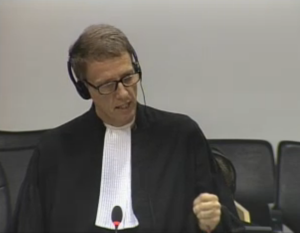
International Nuon Chea Defense Counsel Victor Koppe
Mr. Koppe said that Dr. Beavan submitted that the Vietnamese had put identification numbers on the skulls. The identification numbers only went up to 4,576.[2] Mr. Koppe asked whether he could explain why this number only went up to 4,576. Mr. Vuthy said that she only came for one month and therefore was unable to find out all the identification numbers. The Vietnamese came in groups of three or four to count the bones, but not to analyze the bones. Mr. Koppe said that Dr. Beavan also said that it was unclear why the identification numbers stopped at 4,576 after talking to the expert. The expert replied that when Dr. Beavan came for a visit, she only asked about one specific number.
Mr. Koppe said that 63,112 bones had been found. However, as a human body consists of 206 bones, he said 1,323,344 bones should have been found instead. He wanted to know whether the expert had an explanation for this. The expert replied that the number of rip bones, for example, was only small. The government had prohibited further excavations. He confirmed that the bones were already in the stupa when he started examining them.
“Our team was even more careful than you,” the expert explained. They were aware that there was a Chinese cemetery. He said that they were careful not to include those bones of people who had died outside. All remains bare one had marks of being killed or tortured. The majority were killed, he said, by being hit on the back of their neck. It could also be seen that the throats were slit. Mr. Koppe said that Him Huy never mentioned anything about killing anyone with shooting or bayonets, nor was this mentioned by Tay Teng (who had engaged in the killing at Choeung Ek). Mr. Koppe wanted to know how he could determine that the bones were not added by the Vietnamese later or belonged to the Chinese burial site. At this point, the President adjourned the hearing for a break.
Determining the Origin of Skulls
After the break, Ms. Guissé requested additional time. The Co-Prosecution did not have any objection. The expert said that he had a meeting at the Ministry of Environment in the morning and therefore did not have time tomorrow morning. He had a tight schedule for the first week of January, but was available in the second week. One additional session was granted for the defense teams.
Mr. Koppe then resumed his questioning. He wanted to know how one could verify that the mud and dirt that could be seen on a skull belonged to a victim who died in 1978 and not to someone who was buried in the Chinese graveyard. He replied that there usually was dust on the skulls. Mud could not be cleaned with hands but needed to be cleaned with water, as it firmly stayed on the skull. Mr. Koppe repeated his questioning: how could he verify that the mud came from a grave site at Choeung Ek? He replied that they analyzed the samples for their different components. The mud usually came from the graveyard. The mud was different to the one at different places. They had three points of criteria: First, the mark of killings. The Chinese remains had no signs of killings. Second, the mud on the remains. They needed to study the period when the person died. When Mr. Koppe repeated the question, Mr. Lysak objected and said the question was repetitive. The expert explained that the bones would be different if someone was buried in a coffin, for example. They looked at the skulls under microscope and analyzed the mud.
Marks on the Skulls
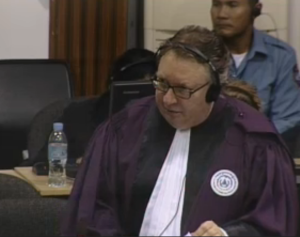
International Senior Assistant Prosecutor Dale Lysak
Mr. Koppe said that he had identified 990 marks of piercing with bayonets.[3] Mr. Koppe asked whether it was correct that Him Huy never mentioned anything of people being shot with bullets or pierced with bayonets. Mr. Koppe wanted to know how the expert could explained that 1,686 showed bullet marks in contrast to Him Huy’s and Tay Teng’s testimony that people were not shot. Mr. Lysak said that this number also included cleaning rods and riffes. Mr. Vuthy could not remember the exact number. Mr. Koppe referred to the same example he had mentioned earlier, namely a female person who had a crack on the skull.[4] Mr. Koppe said that the forensic term was blunt force trauma. Mr. Koppe asked how he concluded that she was “brutally tortured” before being killed and not that the death was the result of four blows. Judge Fenz wanted to know whether he would call it torture if a person was hit four times on the head with a blunt object. He explained that a dent on the head could be seen, which meant that the victim would not die directly. If there was a whole in the head, the victim would die immediately. The blood would seep through the bones and make the victim sick. The blood could also go into the brain. The victim “suffered for quite a long time,” which was why he concluded that the victim was tortured. The changing in color would only happen after three to five days of blood entering the brain and bones. He confirmed that they had to be careful not to introduce new marks onto the remains.[5] Mr. Koppe asked whether it was not correct that skulls that had been there for 35 years could bear all sorts of trauma that was not induced by killings. He answered that they found other marks that were not marks from the killings and that they excluded these marks. When people exhumed the remains, the marks would be new. Thus, they excluded these marks. He gave an example of a victim on which a mark could be found: the wound had started to heal for at least two weeks before the death occurred.
Mr. Koppe inquired how he concluded that the marks were results of torture.[6] He said that there were 1,631 marks of bones being hit against a hard surface. The bone became darker. They had asked Him Huy how long people were detained, who had replied that it was a minimum of two weeks. If a person fell down at S-21, this was a form of torture, he said. The person would have otherwise fell down, for example, in a rice field, and not bore this mark.
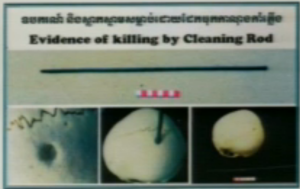
The impact of a cleaning rod on a skull.
Mr. Koppe said that many of these people had been soldiers and whether he was not speculating that the marks were a result of torture and not another form of trauma. He replied that their work was examined on four stages and checked for accuracy. They could determine whether a wound was inflicted on them post- or ante-mortem.
Mr. Koppe inquired about the “11 marks from steel support at the photo chair” and whether this was his own conclusion or his conclusion from what Him Huy told him. He replied that they analyzed the photo chair and looked whether the marks they found matched its size. Mr. Koppe inquired where he found the tools that were used. He asked whether the mark was consistent with the blow on the head. For example, they could not always distinguish whether a wound was inflicted by a bamboo or a wooden stick and they only indicated it when they were certain. He submitted that they did not only rely on the account of one person. It was helpful to rely on Him Huy’s testimony, for example, but they could not solely rely on his testimony.
Kraing Ta Chan
After the break, Mr. Koppe moved to the topic of Kraing Ta Chan. The expert said that they analyzed 1,909 remains.[7] The English translation said 1,904 remains and on the next page 1,904 bones. He replied that the number was 1,904 crania. Mr. Koppe asked whether he analyzed 1,904 crania or bones. He explained that they combined several pieces to one cranium. Mr. Koppe wanted to know whether they were the ones that were seen at the stupa at Kraing Ta Chan. Mr. Koppe said that a total of 10,042 deaths was indicated.[8] Mr. Koppe asked where this number came from. He said that there was a community of “old adults” who worked on the project. “We did not make verification thoroughly on the existing list.” Mr. Koppe wanted to know whether he could give an explanation for the difference in number of crania that he analyzed and the number of deaths that was put forward in other documents. He said that individuals were counted at each grave site. Mr. Vuthy’s team dug a sample at a grave site. The number of 10,042 was obtained through the community. Mr. Koppe concluded his line of questioning, highlighting that he would have wished to put forward more questions.
Back to Choeung Ek
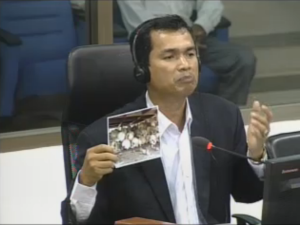
Expert Voeun Vuthy
The floor was handed to the International Co-Prosecutor Dale Lysak, who wanted to know whether all graves were exhumed in 1983 or only parts of them. He replied that there were more than 100 grave sites and that only 86 were exhumed. The Senior Assistant Prosecutor read an extract, in which 129 mass pits existed, revealing a total of 8,985 bodies.[9] The remaining mass grave pits were flooded during rainy season. Thus, only 86 mass graves were exhumed in total. Others were ploughed to become farm fields. Some ordinary people exhumed mass graves to search for hammock strings and clothes. Later, this was banned by the authorities and the authorities themselves exhumed it. This was the local office of the Ministry of Culture and Cult. Mr. Lysak asked whether the Department of Culture and Propaganda had this number.[10] The expert replied that he did not see the original document, but saw those who are responsible for it.
Mr. Lysak asked whether he knew where a publication of 1989 originated from. He answered that he used to see the “Folding Book”, which could be seen at Tuol Sleng Prison. Mr. Lysak presented photograph on the screen that showed lines of skulls. Mr. Lysak asked whether he recognized this photograph. Mr. Vuthy replied that the skulls were lines up for the purpose of being photographed. The original photograph was maintained at Tuol Sleng Museum and was not in the expert’s possession.
Turning to the 43 graves that were not exhumed, Mr. Lysak showed a diagram drawn up by OCIJ that indicated.[11] Those that were not exhumed were close to the flooding area, as no dam had been built yet at the time. There was also mudded area on the other side. They were not allowed to exhume any other pits.
Mr. Lysak inquired whether he personally interviewed Him Huy or whether this was one of his staff members.[12] Mr. Vuthy answered that he interviewed him twice and that six colleagues recorded the interviews. Mr. Lysak asked whether he came across any information that the unearthed graves were smaller in size than those graves that had been exhumed. He answered that they conducted further investigations and that one grave could be filled on one day of execution due to the marks on the earth. In some pits, they executed people, covered it with earth, executed another group of people and then covered it with earth again. They did not know the exact number of pits in each pit.
Mr. Lysak played a video clip of the documentary Die Angkar and photographs.[13] Mr. Lysak asked whether he recognized the location. He answered that it was Choeung Ek. On the first photograph that was then shown to him, one could see the Chinese graves and the location where a stupa was located. The second photograph was also located at Choeung Ek. He said that they could not identify from which direction the last photograph was taken. The fourth photograph was taken from the eastern side of the current stupa towards the southeast at Choeung Ek, where one could see the Chinese stupa.[14] The sign that was posted next to the gravesite indicated the number of crania or bones that were found, for example 145.
S-21
Mr. Lysak asked whether he had conducted any research as to whether S-21 used other locations to bury victims. He answered that Him Huy had said in his interview that initially prisoners were not buried at Choeung Ek, but rather in the vicinity of Tuol Sleng. Him Huy had also said that he thought that no prisoners from Bong Trabeik were killed at Choeung Ek. Mr. Lysak asked whether he and his team had discovered bones around Tuol Sleng. He replied that someone had only found a few skeleton remains. Him Huy, however, had said that people were buried in the vicinity initially. They were buried elsewhere afterwards due to the stench.
For example, when renewing the sewage canal, the remains of a woman were found. The figure 6,426 was from Choeung Ek exclusively. There were 400 more that they had not yet analyzed. Mr. Lysak asked whether there was a clear distinction between the Chinese tombs and the Khmer Rouge mass graves. He replied that they had not yet found remains of the Chinese. Two graves were destroyed. “The question is, where did they bring the bones to? I do not have the answer.” Mr. Lysak presented two photographs to the expert. One of them showed a tomb with Chinese signs on it.[15] He replied that not all tombs had the same signs, but that they were similar. They found four or five coffins. They could conclude that they were Chinese graves, because they conducted a study on the mark or skulls on the grave and could establish the age of the grave. Mr. Lysak asked him to explain how the marks discovered on a Chinese tomb would be different to those of a mass grave. Mr. Vuthy replied that the remains of Chinese descent could not be located. “Again, I have to emphasize that we did not find remains of Chinese descent.” All remains that they discovered bore marks.
At this point, the president asked the expert when he would be available to conclude his testimony if his testimony was not concluded today.
Conservation of Skulls
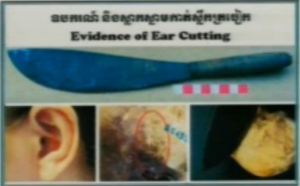
A document shown in court.
After the break, Mr. Lysak inquired about the decrease in number of 8,985 crania that had been mentioned earlier. He wanted to know whether he knew how long the bones and skulls laid on the ground before they were put in the stupa. He answered that they remained on the ground for two to three years. Only after this time period they were put in a stupa. Mr. Lysak presented three photographs to the witness. He confirmed that he had studied the first photograph, on which a wooden photograph was shown.[16] The wooden stupa was not well-maintained and there was no protection mechanism.[17] The next photograph showed the concrete stupa that still stands today. It was built in 1988 or 1989. He did not know whether bones were properly counted when they moved the bones from one stupa to the next. Insects could enter the stupa, which destroyed some of the bones. Mr. Lysak wanted to know what year the changes were made to keep insects and rats out. He explained that they restructured the stupa and used a mechanism to exhaust the humidity from 1988 onwards. Mr. Lysak asked whether he alleged that the number of Vietnamese identification numbers that appeared in Dr. Beavan’s report were incorrect. He replied that the highest number going up to 4,000 was incorrect. There was another figure that went over 7,000.
Mr. Lysak said that the third line of a chart that was presented on the screen that indicated that 7,708 right humerus bones and 7,713 left humerus bones were found. Mr. Lysak asked whether this did not mean that there were at least 7,708 bodies that were exhumed at Choeung Ek. He answered that this was from a different skeletal analysis. Mr. Koppe asked whether he could explain why there seemed to be a greater deterioration of crania than of humerus bones. He said that there were three possible explanations: first, some were used to make the shape of a map at Tuol Sleng Museum. Second, some fell back into the graves. Some skulls may have been borrowed for an exhibition in Vietnam but were never returned.
Mr. Lysak asked whether they were talking exclusively about skulls when, for example, 1,631 entities showed signs of heavy slamming against a wall. He replied that they exclusively looked at skulls.
Mr. Lysak asked about trauma inflicted upon by bamboo sticks.[18] He said that one can see that the skull was fractured as a result of beating. Mr. Lysak asked whether it was correct that he found multiple marks of trauma on most of the skulls, which the expert confirmed. On each, they could at least find two, and the maximum was nine. Mr. Lysak presented another example.[19] The witness explained that it was the impact of an iron tool used to hit the victim. Some victims were hit from the back and some from the side.
Mr. Lysak then turned to the cutting of the throats and wanted to know whether the expert could see this when examining the crania. He answered that Him Huy had said that the throats were slit. If the victims were slit very severely, the head could have almost been cut off. He pointed to the difference between slitting and cutting and said that some bones did not show marks when they were not cut severely.
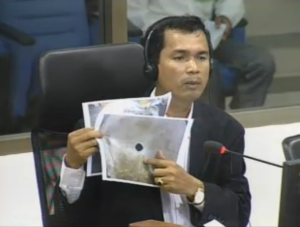
Expert Voeun Vuthy shows a skull that was impacted by a bullet.
Mr. Lysak turned back to the indication that 1,686 crania showed signs of bullets and cleaning rod of rifles. He explained that the victim would not immediately die but would cause severe injury. Usually, victims would not die immediately. There were two holes on both sides for bullets. They could make the distinction between bullets and cleaning rods at some skulls. The string used to tie the hands was the example that they showed to the younger generation. The center had copied the photograph from Tuol Sleng.
Another photograph showed the trauma of cutting an ear.[20] One could see the mark of a knife.
Kraing Ta Chan
Mr. Lysak said that a commune chief had testified about the exhumation of eight pits at Kraing Ta Chan who had said that not all pits had yet been dug up.[21] He answered that if the commune chief had exhumed the pits, they may have not been directly involved in the exhumation but were looking for other belongings. “There are marks at the three pits. He made mention of eight pits, but I have found 11 pits.” Some of the pits were outside of the fence. The commune chief said that no one was in charge of the location and that some remains were eaten by cows and cattle. Victims were killed and dumped into a trench or canal. Mr. Lysak said that there was some additional digging by families in 1981, 1982, and 1983. He asked when the bones were placed into a stupa at Kraing Ta Chan. He was told that only around 200 skulls remained from the wooden stupa and then transferred to the concrete stupa. However, he discovered later that there were more than 1,000 skulls. Mr. Lysak showed a photograph of a wooden structure.[22] The expert replied that he had not seen the wooden structure himself. Mr. Lysak asked how long the bones were stored in this wooden structure and whether they were moved to another location later. He replied that the remains were left unattended for a long time, because “no one really understood the importance of the remains.” This was in 1989. Before 1990, almost no one dared to go to that location. [23] The expert that they complied with standardized international criteria. The killings at Wat Tipadei were usually the result of a range of tools. “The way of torture was systematically used.” He was uncertain whether the methods of torture at Kraing Ta Chan were copied from Kampong Speu or Choeung Ek.
The president announced that the hearing of the expert would continue sometime in January. Tomorrow, the testimony of 2-TCW-971 will continue via audiovisual link.
[1] E3/10643, at 01235398 (EN), 01235461 (KH).
[2] E3/10766.
[3] E3/10765, at
[4] E3/10646, 6201.
[5] At page 5; 01235385 (EN), 01235440 (KH).
[6] At 01336753 (EN).
[7] E3/10769
[8] E3/2763, at 00379115 (EN & KH), 00795897 (FR).
[9] E3/10645.
[10] At 01235383 (EN), 01235436 (KH).
[11] E3/2160.
[12] E3/10767, at 01319503 (KH), 01336776 (EN), 01336800 (FR).
[13] E3/3095R, at 42:17.
[14] E3/8116.
[15] E3/7991; E3/8116.
[16] E3/8063.103; E3/8063.70; E3/8144
[17] E3/8116.
[18] E3/10647.
[19] E3/10647.
[20] E3/10647.
[21] E3/5837, at 00223457 (EN), 00163462 (KH), 00178095 (FR).
[22] E3/8153.
[23] At 01359103.
